Research on a Neutron Detector with a Boron-Lined Multilayer Converter
Abstract
1. Introduction
2. Physical Design and Optimization
3. Experiments with 241Am–239Pu Mixture Source
4. Experiments with Photo-Neutron Source
5. Conclusions
Author Contributions
Funding
Institutional Review Board Statement
Informed Consent Statement
Data Availability Statement
Acknowledgments
Conflicts of Interest
References
- Hurd, A.J.; Kouzes, R.T. Why new neutron detector materials must replace helium-3. Eur. Phys. J. Plus 2014, 129, 1–3. [Google Scholar] [CrossRef]
- Kouzes, R.T.; Lintereur, A.T.; Siciliano, E.R. Progress in alternative neutron detection to address the helium-3 shortage. Nucl. Instrum. Methods Phys. Res. Sect. A Accel. Spectrometers Detect. Assoc. Equip. 2015, 784, 172–175. [Google Scholar] [CrossRef]
- Kouzes, R.T. The 3He Supply Problem; Pacific Northwest National Lab. (PNNL): Richland, WA, USA, 2009.
- Shea, D.A.; Morgan, D.L. The Helium-3 Shortage: Supply, Demand, and Options for Congress; Congressional Research Service: Washington, DC, USA, 2010.
- Arkharov, A.M.; Arkharov, I.A.; Dolgopyatov, D.A.; Bondarenko, V.L. 3He supply crisis: Reasons and challenges. Chem. Petrol. Eng. 2013, 49, 41–45. [Google Scholar] [CrossRef]
- Lacy, J.L.; Athanasiades, A.; Martin, C.S.; Sun, L.; Vazquez-Flores, G.J.; Lyons, T.D. Boron-coated straw detectors: A novel approach for helium-3 neutron detector replacement. In Proceedings of the IEEE Nuclear Science Symposuim & Medical Imaging Conference, Knoxville, TN, USA, 30 October–6 November 2010; pp. 3971–3975. [Google Scholar]
- Lacy, J.L.; Athanasiades, A.; Martin, C.S.; Sun, L.; Vazquez-Flores, G.J. Boron-coated straw detectors for backpack monitors. IEEE Trans. Nucl. Sci. 2013, 60, 1111–1117. [Google Scholar] [CrossRef]
- Weimar, J.; Köhli, M.; Allmendinger, F.; Schmidt, U. Large-scale boron-lined neutron detectors for Cosmic-Ray Neutron Sensing. Geophys. Res. Abstr. 2019, 21, 1. [Google Scholar]
- Weimar, J.; Köhli, M.; Budach, C.; Schmidt, U. Large-scale boron-lined neutron detection systems as a 3He alternative for cosmic ray neutron sensing. Front. Water 2020, 2, 544806. [Google Scholar] [CrossRef]
- Deng, C.; Tuo, X.; Peng, S.; Yu, Y.; Fang, Z.; Wang, Q.; Liu, L.; Yang, Y. An angular sensitivity study of the boron-lined honeycomb convertor neutron detector used for the small angle neutron scattering. In Proceedings of the 2019 IEEE Nuclear Science Symposium and Medical Imaging Conference (NSS/MIC), Manchester, UK, 26 October–2 November 2019; pp. 1–3. [Google Scholar]
- Piscitelli, F.; Mauri, G.; Messi, F.; Anastasopoulos, M.; Arnold, T.; Glavic, A.; Höglund, C.; Ilves, T.; Higuera, I.L.; Pazmandi, P.; et al. Characterization of the Multi-Blade 10B-based detector at the CRISP reflectometer at ISIS for neutron reflectometry at ESS. J. Instrum. 2018, 13, P05009. [Google Scholar] [CrossRef]
- Anastasopoulos, M.; Bebb, R.; Berry, K.; Birch, J.; Bryś, T.; Buffet, J.-C.; Clergeau, J.-F.; Deen, P.; Ehlers, G.; Van Esch, P.; et al. Multi-Grid detector for neutron spectroscopy: Results obtained on time-of-flight spectrometer CNCS. J. Instrum. 2017, 12, P04030. [Google Scholar] [CrossRef]
- Piscitelli, F. Novel boron-10-based detectors for neutron scattering science: Helium-3-free detectors for large-and small-area applications: The Multi-Grid and the Multi-Blade prototypes. Eur. Phys. J. Plus 2015, 130, 1–9. [Google Scholar] [CrossRef]
- Albani, G.; Cippo, E.P.; Croci, G.; Muraro, A.; Schooneveld, E.; Scherillo, A.; Hall-Wilton, R.; Kanaki, K.; Höglund, C.; Hultman, L.; et al. Evolution in boron-based GEM detectors for diffraction measurements: From planar to 3D converters. Meas. Sci. Technol. 2016, 27, 115902. [Google Scholar] [CrossRef]
- Lacy, J.L.; Athanasiades, A.; Sun, L.; Martin, C.S.; Lyons, T.D.; Foss, M.A.; Haygood, H.B. Boron-coated straws as a replacement for 3He-based neutron detectors. Nucl. Instrum. Methods Phys. Res. Sect. A Accel. Spectrometers Detect. Assoc. Equip. 2011, 652, 359–363. [Google Scholar] [CrossRef]
- Chen, C.; Gong, H.; Yang, Y.; Zhu, S.; Huang, T.; Wang, Y.; Wang, X.; Li, Y. Realization and test of position sensitive boron coated straw-tube. In Proceedings of the 2013 IEEE Nuclear Science Symposium and Medical Imaging Conference (2013 NSS/MIC), Seoul, Republic of Korea, 27 October–2 November 2013; pp. 1–4. [Google Scholar]
- Birch, J.; Buffet, J.C.; Correa, J.; van Esch, P.; Guérard, B.; Hall-Wilton, R.; Höglund, C.; Hultman, L.; Khaplanov, A.; Piscitelli, F. 10B4C Multi-Grid as an Alternative to 3He for Large Area Neutron Detectors. IEEE Trans. Nucl. Sci. 2013, 60, 871–878. [Google Scholar] [CrossRef]
- Khaplanov, A. Multi-Grid Boron-10 detector for large area applications in neutron scattering science. arXiv 2012, arXiv:1209.0566. [Google Scholar]
- Yang, Y.; Li, C.; Chen, C.; Wang, X.; Li, Y. Research of boron lined honey-neutron detector realized with atomic layer deposition. In Proceedings of the 2013 IEEE Nuclear Science Symposium and Medical Imaging Conference (2013 NSS/MIC), Seoul, Republic of Korea, 26 October–2 November 2013; pp. 1–3. [Google Scholar]
- Fang, Z.; Yang, Y.; Li, Y. The research of high detection efficiency boron lined detector with a honeycomb neutron converter. In Proceedings of the 2015 IEEE Nuclear Science Symposium and Medical Imaging Conference (NSS/MIC), San Diego, CA, USA, 31 October–7 November 2015; pp. 1–4. [Google Scholar]
- Fang, Z.; Yang, Y.; Li, Y.; Zhang, Z.; Wang, X. Research on a neutron detector with a boron-lined honeycomb neutron converter. IEEE Trans. Nucl. Sci. 2017, 64, 1048–1055. [Google Scholar] [CrossRef]
- Mauri, G.; Apostolidis, I.; Christensen, M.J.; Glavic, A.; Lai, C.C.; Laloni, A.; Messi, F.; Olsson, A.L.; Robinson, L.; Stahn, J.; et al. The Multi-Blade Boron-10-based neutron detector performance using a focusing reflectometer. J. Instrum. 2020, 15, P03010. [Google Scholar] [CrossRef]
- Piscitelli, F.; Messi, F.; Anastasopoulos, M.; Bryś, T.; Chicken, F.; Dian, E.; Fuzi, J.; Höglund, C.; Kiss, G.; Orban, J.; et al. The Multi-Blade Boron-10-based neutron detector for high intensity neutron reflectometry at ESS. J. Instrum. 2017, 12, P03013. [Google Scholar] [CrossRef]
- Yang, L.; Zhou, J.R.; Sun, Z.J.; Zhang, Y.; Huang, C.-Q.; Sun, G.-A.; Wang, Y.-F.; Yang, G.-A.; Xu, H.; Xie, Y.-G.; et al. Experimental research on a THGEM-based thermal neutron detector. Chin. Phys. C 2015, 39, 056002. [Google Scholar] [CrossRef][Green Version]
- Croci, G.; Claps, G.; Cazzaniga, C.; Foggetta, L.; Muraro, A.; Valente, P. GEM-based detectors for thermal and fast neutrons. Eur. Phys. J. Plus 2015, 130, 1–8. [Google Scholar] [CrossRef]
- Li, K.; Zhou, J.R.; Wang, X.D.; Xiong, T.; Zhang, Y.; Xie, Y.G.; Zhou, L.; Xu, H.; Yang, G.A.; Wang, Y.F.; et al. Study of a nTHGEM-based thermal neutron detector. Chin. Phys. C 2016, 40, 076002. [Google Scholar] [CrossRef]
- Li, G.; Xie, Y.; Zhao, H.; Yan, W.-Q.; Li, Y.-L.; Peng, Z.-Y.; Hu, T.; Lv, J.-G.; Zhou, L. A new neutron detector based on ceramic THGEM and boron-coated meshes. Radiat. Detect. Technol. Methods 2018, 2, 1–9. [Google Scholar] [CrossRef]
- Fang, Z.; Yang, Y.; Li, Y.; Wang, X. The research on the suppression of spurious neutrons for a neutron detector array that may be used in the neutron scattering. In Proceedings of the 2017 IEEE Nuclear Science Symposium and Medical Imaging Conference (NSS/MIC), Atlanta, GA, USA, 21–28 October 2017; pp. 1–4. [Google Scholar]
- Agostinelli, S.; Allison, J.; Amako, K.; Apostolakis, J.; Araujo, H.; Arce, P.; Asai, M.; Axen, D.; Banerjee, S.; Barrand, G.; et al. GEANT4-a simulation toolkit. Nucl. Instrum. Methods Phys. Res. Sect. A Accel. Spectrometers Detect. Assoc. Equip. 2003, 506, 250–303. [Google Scholar] [CrossRef]
- Allison, J.; Amako, K.; Apostolakis, J.E.A.; Araujo, H.; Dubois, P.A.; Asai, M.; Barrand, G.; Capra, R.; Chauvie, S.; Chytracek, R.; et al. Geant4 developments and applications. IEEE Trans. Nucl. Sci. 2006, 53, 270–278. [Google Scholar] [CrossRef]
- Allison, J.; Amako, K.; Apostolakis, J.; Arce, P.; Asai, M.; Aso, T.; Bagli, E.; Bagulya, A.; Banerjee, S.; Barrand, G.; et al. Recent developments in Geant4. Nucl. Instrum. Methods Phys. Res. Sect. A Accel. Spectrometers Detect. Assoc. Equip. 2016, 835, 186–225. [Google Scholar] [CrossRef]
- Azevedo, C.D.R.; Correia, P.M.M.; Carramate, L.; Silva, A.; Veloso, J. THGEM gain calculations using Garfield++: Solving discrepancies between simulation and experimental data. J. Instrum. 2016, 11, P08018. [Google Scholar] [CrossRef][Green Version]
- Pfeiffer, D.; De Keukeleere, L.; Azevedo, C.; Belloni, F.; Biagi, S.; Grichine, V.; Hayen, L.; Hanu, A.R.; Hřivnáčová, I.; Ivanchenko, V.; et al. Interfacing Geant4, Garfield++ and Degrad for the simulation of gaseous detectors. Nucl. Instrum. Methods Phys. Res. Sect. A Accel. Spectrometers Detect. Assoc. Equip. 2019, 935, 121–134. [Google Scholar] [CrossRef]
- Deng, C.; Wang, Q.; Wu, Y.; Peng, S.; Liu, F.; Li, H.; Cheng, J.; Tuo, X. Preparation and characterization of boron films used for boron-lined gaseous neutron detectors. J. Korean Phys. Soc. 2021, 79, 606–612. [Google Scholar] [CrossRef]
- Fang, Z.; Deng, C.; Guérard, B.; Yang, Y.; Li, Y.; Zhang, Z.; Wang, X. Realization and evaluation of the Boron Nano Particle-based drip-coating method for boron-lined gaseous neutron detectors. J. Instrum. 2019, 14, P12003. [Google Scholar] [CrossRef]
- Charpak, G. Multiwire Chambers, Drift Chambers and Some of their Applications. Europhys. News 1979, 10, 7–10. [Google Scholar] [CrossRef][Green Version]
- Charpak, G.; Sauli, F. Multiwire proportional chambers and drift chambers. Nucl. Instrum. Methods 1979, 162, 405–428. [Google Scholar] [CrossRef]
- Deng, C.; Liu, F.; Wang, Q.; Tuo, X.; Peng, S.; Wu, Y.; Yang, H.; Dai, H. Research on angle sensitivity of the boron-lined multilayer converter neutron detector. Meas. Sci. Technol. 2022, 33, 065901. [Google Scholar] [CrossRef]
- Zhao, Y.; Cui, T.; Yang, Y. The design of a photoneutron source for the narcotic drugs detection in a large-truck. In Proceedings of the 2017 IEEE Nuclear Science Symposium and Medical Imaging Conference (NSS/MIC), Atlanta, GA, USA, 21–28 October 2017; pp. 1–3. [Google Scholar]
- Cui, T.; Yang, Y.; Zhang, Z.; Zong, C.; Ming, S.; Wang, D. An e-LINAC driven PGNAA system for concealed drug inspection. In Proceedings of the 2020 IEEE Nuclear Science Symposium and Medical Imaging Conference (NSS/MIC), Boston, MA, USA, 31 October–7 November 2020; pp. 1–2. [Google Scholar]
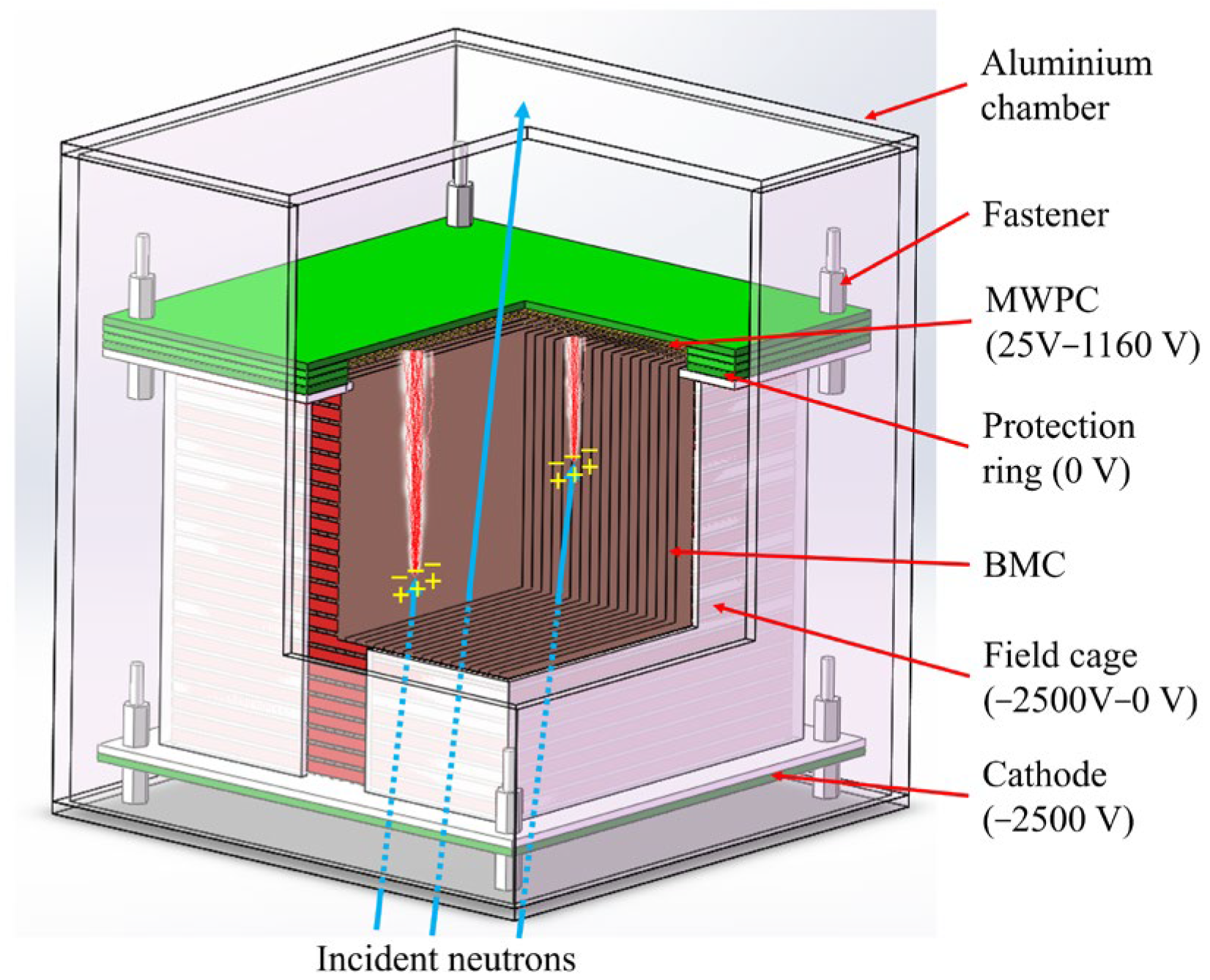

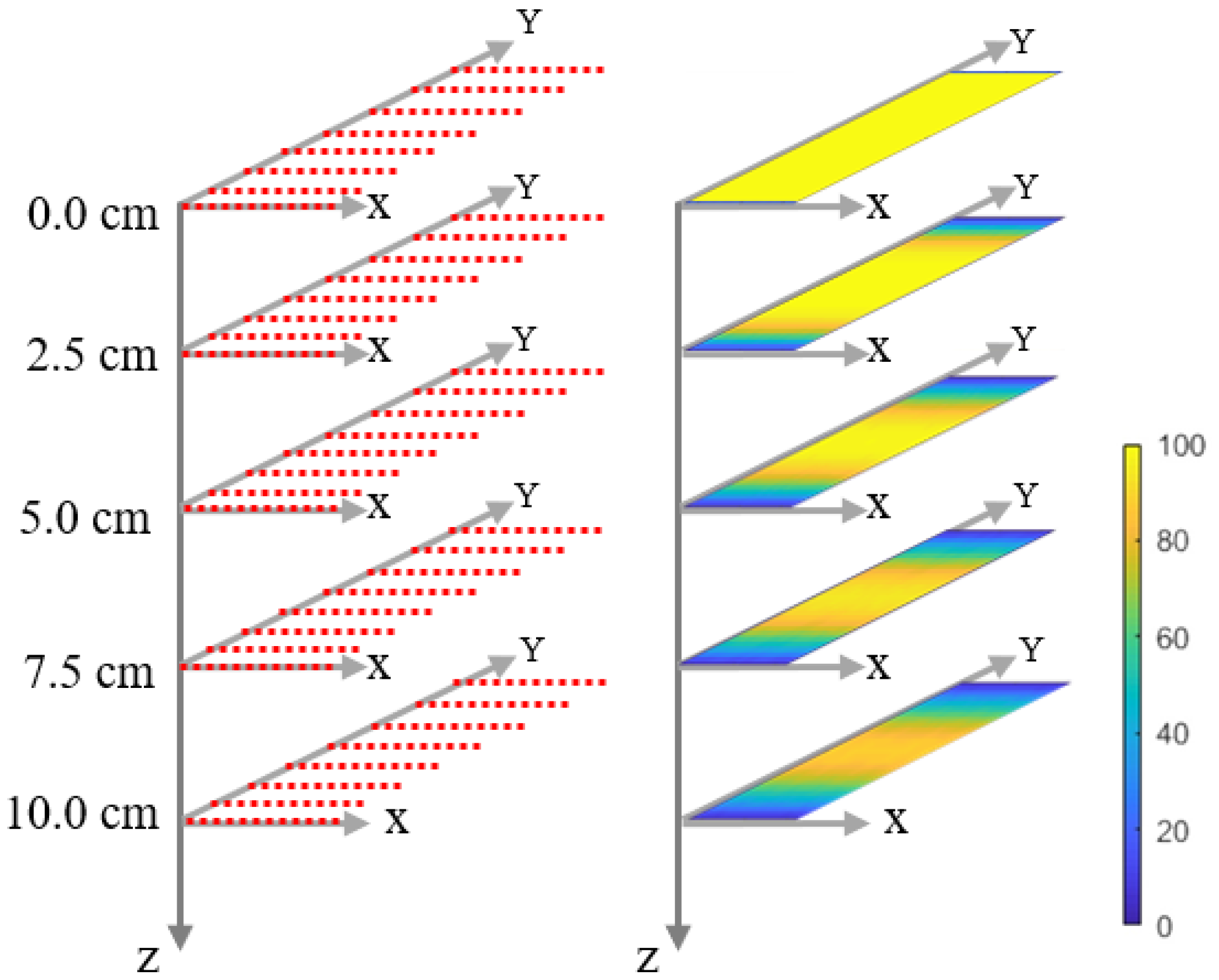
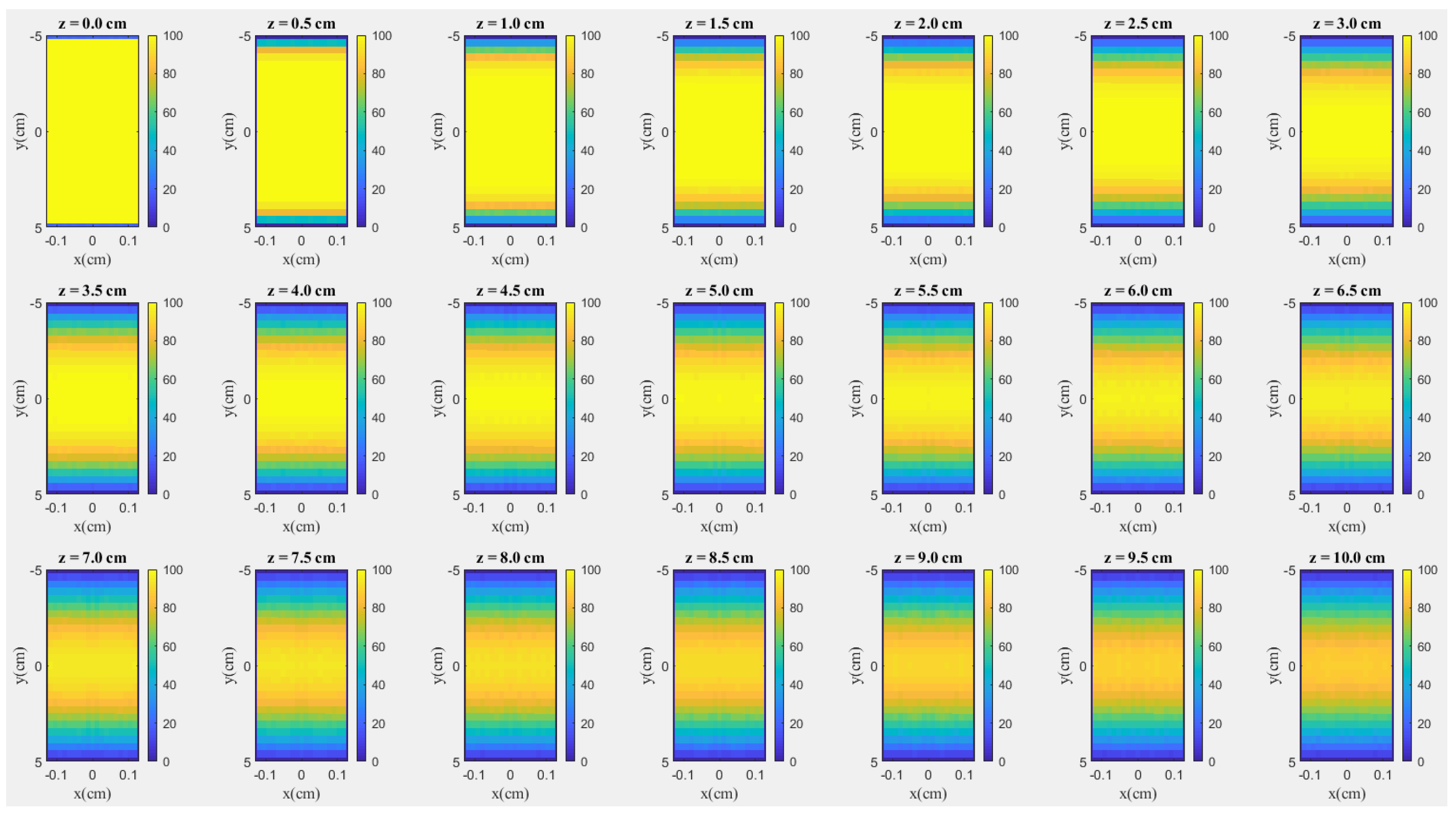


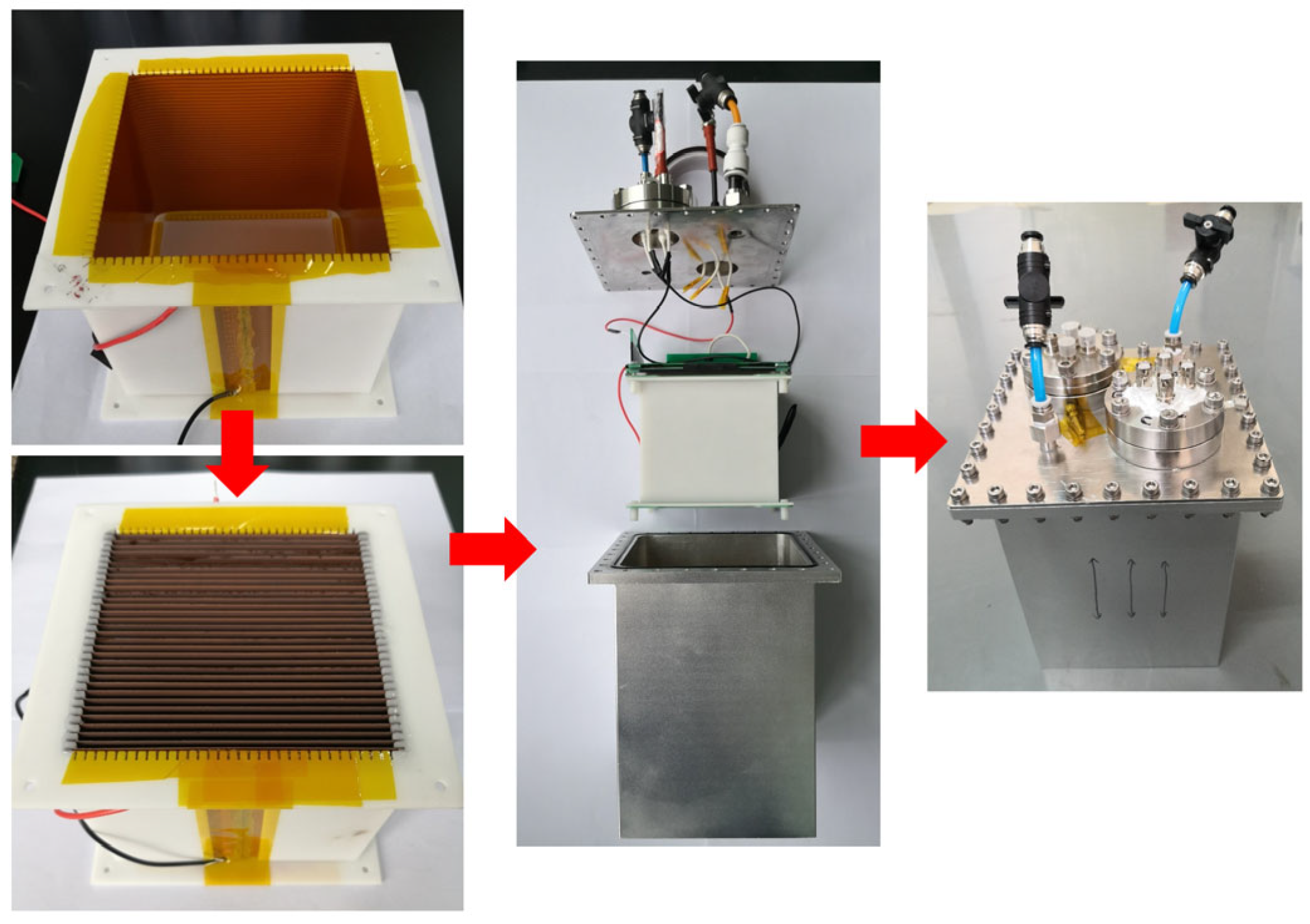
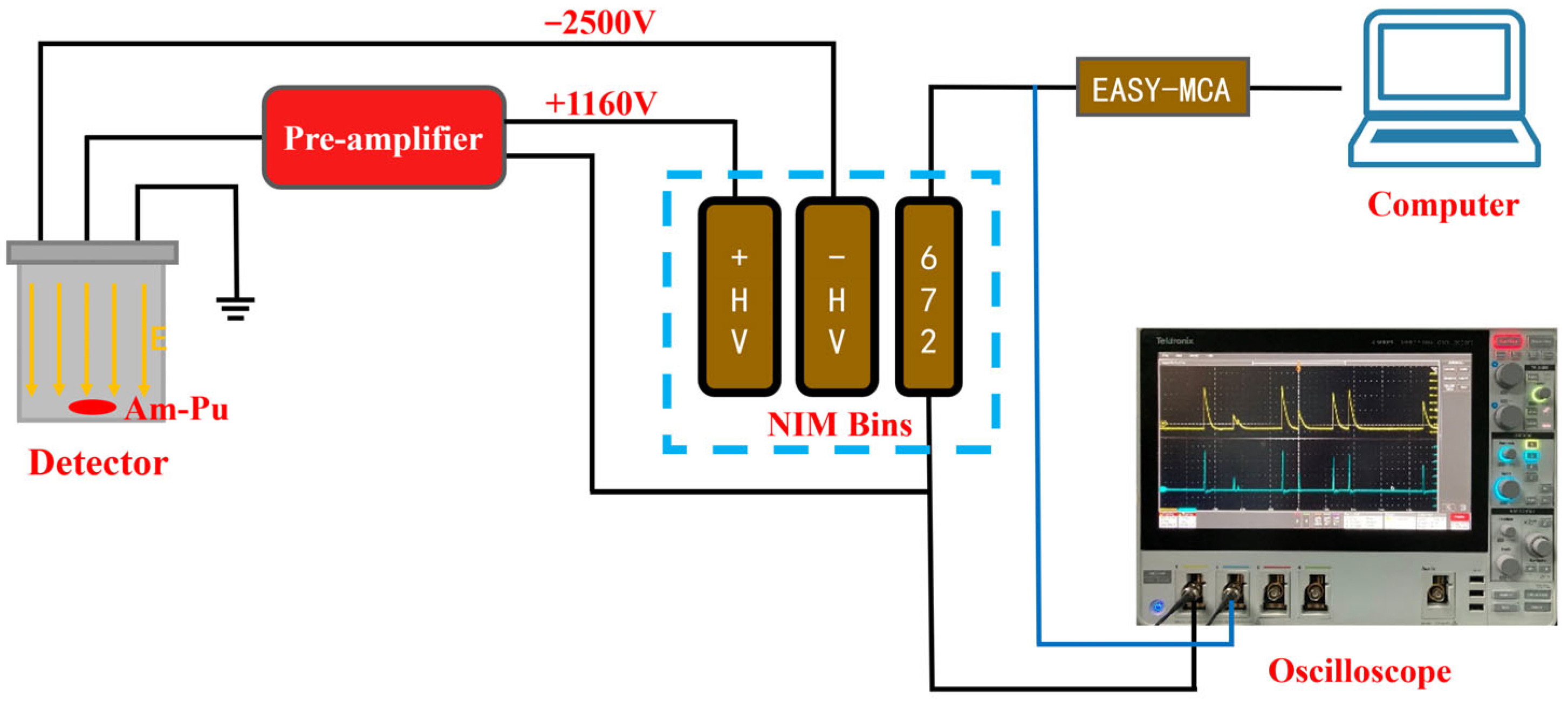
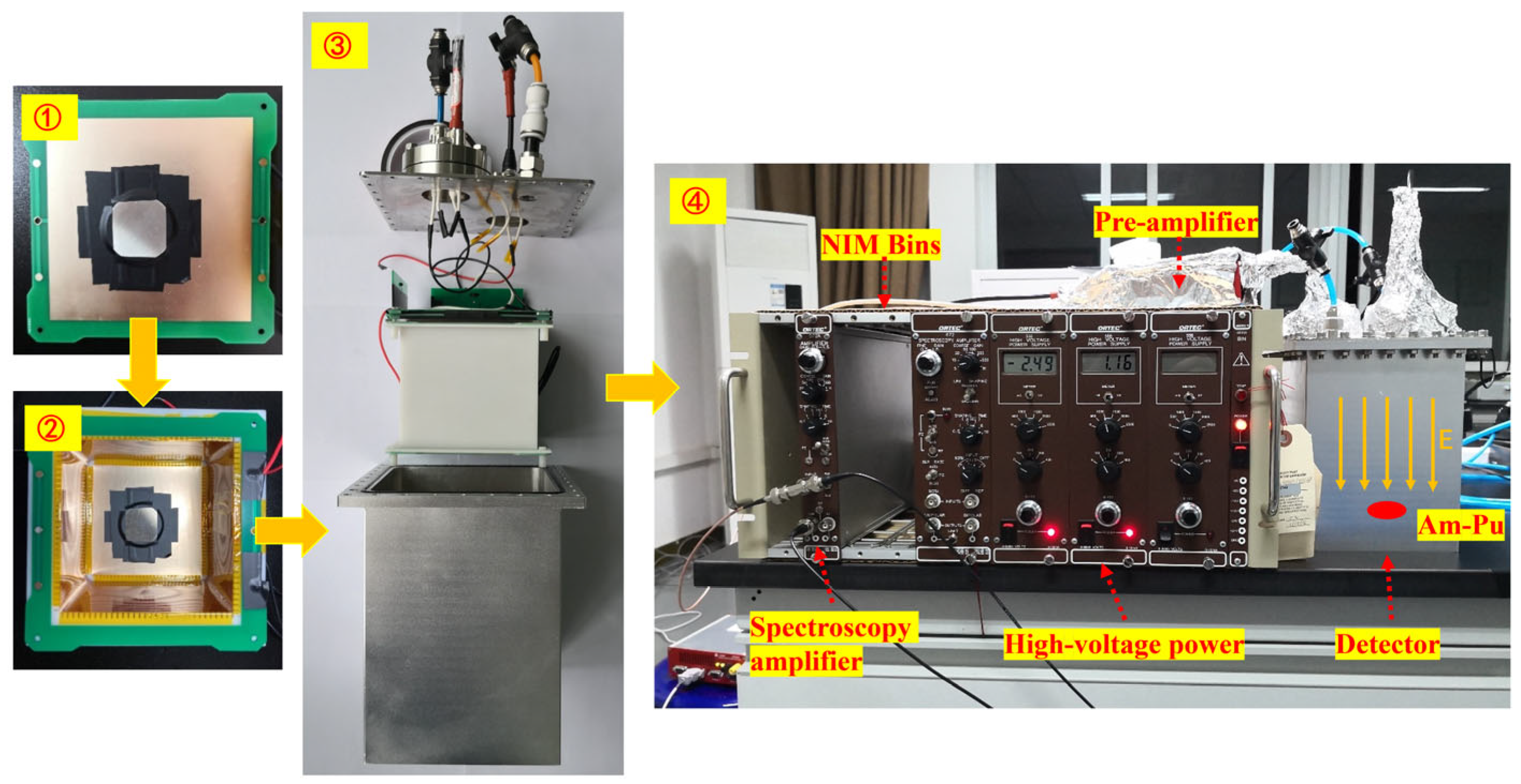

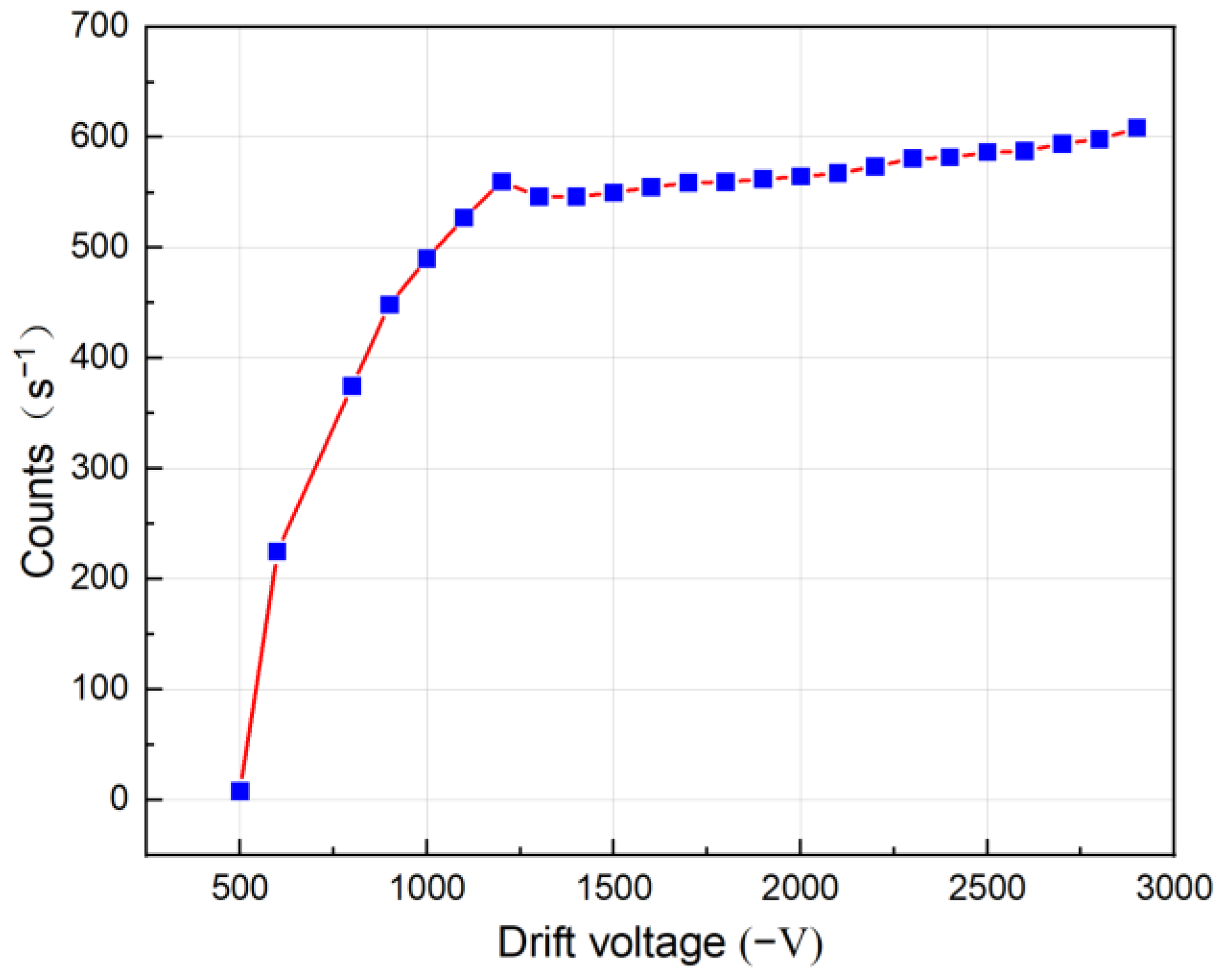

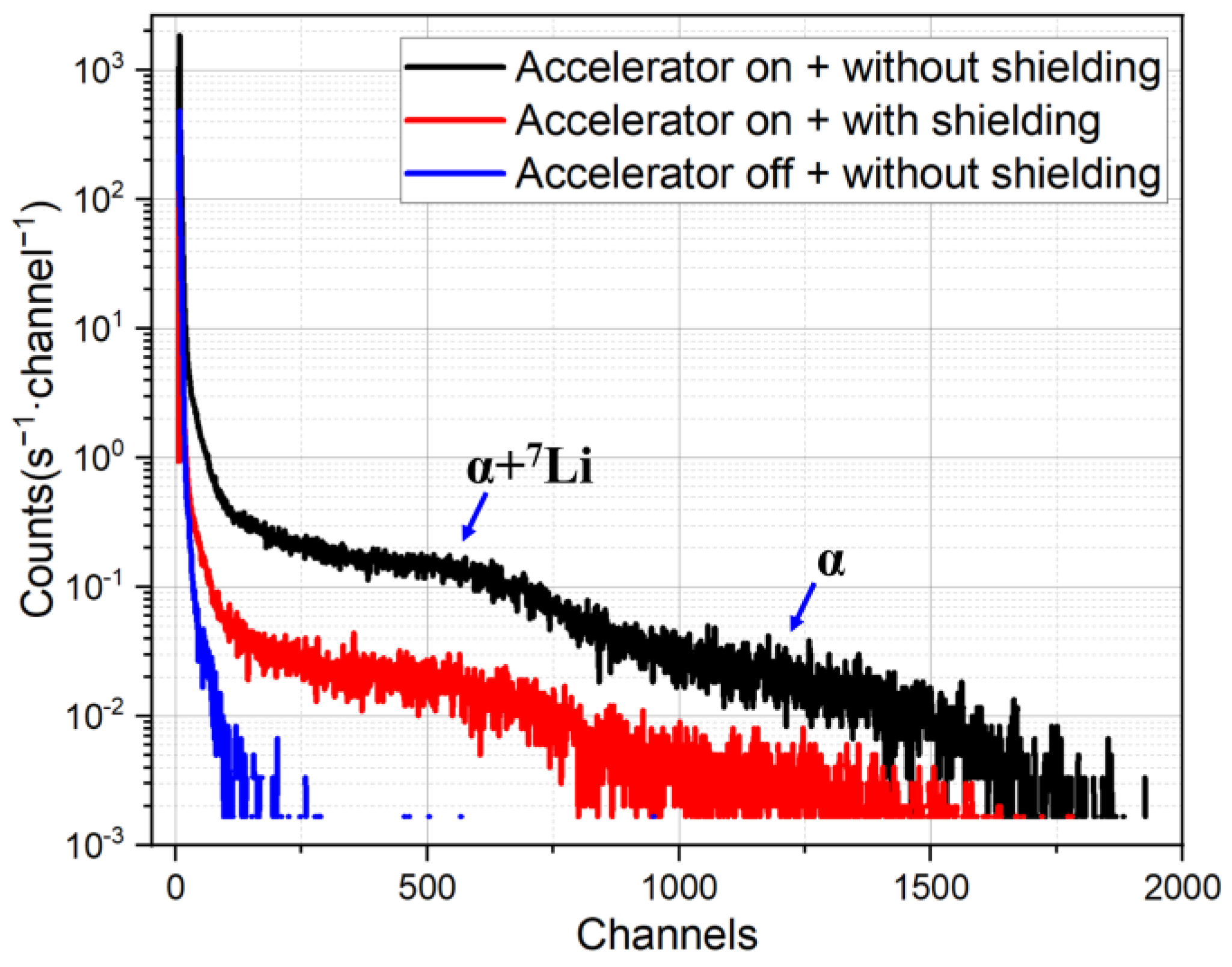
| Source Number | Nuclide | Particle Emission Rate over 2π (s−1) |
|---|---|---|
| AMPU1103 | Am-241 | 282.2 |
| Pu-239 | 390.7 | |
| Reference Time | 10 August 2011 | |
| Expanded Uncertainty (k = 2) | 2.5% | |
Disclaimer/Publisher’s Note: The statements, opinions and data contained in all publications are solely those of the individual author(s) and contributor(s) and not of MDPI and/or the editor(s). MDPI and/or the editor(s) disclaim responsibility for any injury to people or property resulting from any ideas, methods, instructions or products referred to in the content. |
© 2024 by the authors. Licensee MDPI, Basel, Switzerland. This article is an open access article distributed under the terms and conditions of the Creative Commons Attribution (CC BY) license (https://creativecommons.org/licenses/by/4.0/).
Share and Cite
Deng, C.; Hu, Q.; Li, P.; Wang, Q.; Xie, B.; Yang, J.; Tuo, X. Research on a Neutron Detector with a Boron-Lined Multilayer Converter. Appl. Sci. 2024, 14, 4269. https://doi.org/10.3390/app14104269
Deng C, Hu Q, Li P, Wang Q, Xie B, Yang J, Tuo X. Research on a Neutron Detector with a Boron-Lined Multilayer Converter. Applied Sciences. 2024; 14(10):4269. https://doi.org/10.3390/app14104269
Chicago/Turabian StyleDeng, Chao, Qin Hu, Pengcheng Li, Qibiao Wang, Bo Xie, Jianbo Yang, and Xianguo Tuo. 2024. "Research on a Neutron Detector with a Boron-Lined Multilayer Converter" Applied Sciences 14, no. 10: 4269. https://doi.org/10.3390/app14104269
APA StyleDeng, C., Hu, Q., Li, P., Wang, Q., Xie, B., Yang, J., & Tuo, X. (2024). Research on a Neutron Detector with a Boron-Lined Multilayer Converter. Applied Sciences, 14(10), 4269. https://doi.org/10.3390/app14104269






